List of Counts Palatine of the Rhine
The Elector of the Palatinate (German: Kurfürst von der Pfalz) ruled the Palatinate of the Rhine in the Kingdom of Germany and the Holy Roman Empire from 915 to 1803.
Counts Palatine of Lotharingia, 915–1085
The Palatinate emerged from the County Palatine of Lotharingia, which came into existence in the 10th century.
- Wigeric of Lotharingia, count of the Bidgau (c. 915/916–922)
- Godfrey, count of the Jülichgau (c. 940)
House of Ezzonen
During the 11th century, the Palatinate was dominated by the Ezzonian dynasty, who governed several counties on both banks of the Rhine. These territories were centered around Cologne-Bonn, but extended south to the Mosel and Nahe Rivers. The southernmost point was near Alzey.[1]
- Hermann I of Lotharingia, 945–994
- Ezzo of Lotharingia, 994–1034
- Otto I of Lotharingia, 1034–45 (Duke of Swabia 1045–47)
- Heinrich I of Lotharingia, 1045–61
- Hermann II of Lotharingia, 1061–85 (in tutelage to Anno II, archbishop of Cologne until 1064)
Counts Palatine of the Rhine, 1085–1356
From about 1085/1086, after the death of the last Ezzonian palatine count, Herman II of Lotharingia, the Palatinate lost its military importance in Lotharingia. The territorial authority of the count palatine was reduced to his counties along the Rhine, from then on called County Palatine of the Rhine.
- Heinrich II of Laach, 1085–95
- Sigfried of Ballenstadt, 1095–1113
- Gottfried of Kalw, 1113–29
- William of Ballenstedt, 1129–39
- Henry IV Jasomirgott, 1139–42
- Hermann III of Stahleck, 1142–55
Hohenstaufen Counts Palatine
The first hereditary Count Palatine of the Rhine was Conrad of Hohenstaufen who was the younger brother of Emperor Frederick Barbarossa. The territories attached to this hereditary office started from those held by the Hohenstaufens in Franconia and Rhineland (other branches of the Hohenstaufens received other areas including Swabian lands and Franche-Comté). Much of this originated from their imperial ancestors, the Franconian emperors, and a part from Conrad's maternal ancestry, the Saarbrücken. This background helps to explain the composition of the inheritance that comprised the Upper and Rhenish Palatinate in the following centuries.
- Conrad of Hohenstaufen 1156–95
Welf Counts Palatine
In 1195, the Palatinate passed to the House of Welf through the marriage of Agnes, heir to the Staufen count.
Wittelsbach Counts Palatine
In the early 13th century, with the marriage of the Welf heiress Agnes, the territory fell to the Wittelsbach Dukes of Bavaria, who were also dukes and counts palatine of Bavaria.
During a later division of territory among the heirs of Duke Louis II of Upper Bavaria in 1294, the elder branch of the Wittelsbachs came into possession of both the Rhenish Palatinate and the territories in the Bavarian "Nordgau" (Bavaria north of the Danube river) with the centre around the town of Amberg. As this region was politically connected to the Rhenish Palatinate, the name Upper Palatinate (Oberpfalz) became common from the early 16th century in contrast to the Lower Palatinate along the Rhine.
With the Treaty of Pavia in 1329, the emperor Louis IV, a son of Louis II, returned the Palatinate to his nephews Rudolf and Rupert.
Electors of the Palatinate, 1356–1777
In the Golden Bull of 1356, under circumvention of inner-wittelsbach contracts, thus crossing over Bavaria, the Palatinate was recognized as one of the secular electorates, and given the hereditary offices of archsteward (Erztruchseß) of the Empire and imperial vicar (Reichsverweser) of Franconia, Swabia, the Rhine, and southern Germany. From that time forth, the Count Palatine of the Rhine was usually known as the Elector Palatine (Kurfürst von der Pfalz). The position as prince-elector had already existed earlier (for example, two rival kings of Germany were elected in 1257: Richard of Cornwall and Alfonso of Castile) though it is difficult to determine the exact start of that office.
Due to the practice of dividing territories among different branches of the family, by the early 16th century junior lines of the Palatine Wittelsbachs came to rule in Simmern, Kaiserslautern, and Zweibrücken in the Lower Palatinate, and in Neuburg and Sulzbach in the Upper Palatinate. The Elector Palatine, now based in Heidelberg, adopted Lutheranism in the 1530s and Calvinism in the 1550s.
First Electorate, 1356–1648
| Wittelsbach dynasty | ||||
| Image | Name | Began | Ended | Notes |
|---|---|---|---|---|
 |
Rupert I Ruprecht I |
10 January 1356 | 16 February 1390 | As Rupert I above |
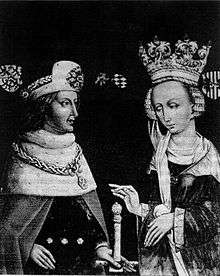 |
Rupert II Ruprecht II |
16 February 1390 | 6 January 1398 | Nephew of Rupert I, son of Adolf |
.jpg) |
Rupert III Ruprecht III |
6 January 1398 | 18 May 1410 | Son of Rupert II, elected King of Germany in 1400 |
.jpg) |
Louis III Ludwig III |
18 May 1410 | 30 December 1436 | Son of Rupert III |
 |
Louis IV Ludwig IV |
30 December 1436 | 13 August 1449 | Son of Louis III |
 |
Frederick I Friedrich I |
13 August 1449 | 12 December 1476 | Brother of Louis IV |
 |
Philip Philipp |
12 December 1476 | 28 February 1508 | Son of Louis IV |
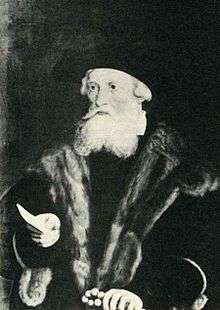 |
Louis V Ludwig V |
28 February 1508 | 16 March 1544 | Son of Philip |
 |
Frederick II Friedrich II |
16 March 1544 | 26 February 1556 | Brother of Louis V |
 |
Otto Henry Ottheinrich |
26 February 1556 | 12 February 1559 | Nephew of Frederick II, son of Rupert of Freising |
| Line of Simmern | ||||
| Image | Name | Began | Ended | Notes |
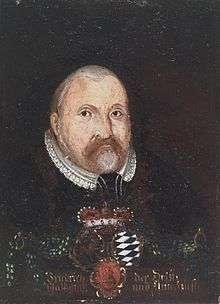 |
Frederick III Friedrich III |
12 February 1559 | 26 October 1576 | When the senior branch of the family died out in 1559, the Electorate passed to Frederick III of Simmern, a staunch Calvinist, and the Palatinate became one of the major centers of Calvinism in Europe, supporting Calvinist rebellions in both the Netherlands and France. |
| Louis VI Ludwig VI |
26 October 1576 | 22 October 1583 | Son of Frederick III | |
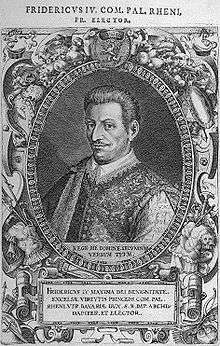 |
Frederick IV Friedrich IV |
22 October 1583 | 19 September 1610 | Son of Louis VI. With his adviser Christian of Anhalt, founded the Evangelical Union of Protestant states in 1608. |
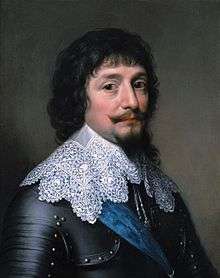 |
Frederick V Friedrich V |
19 September 1610 | 23 February 1623 | Son of Frederick IV and married to Elizabeth, daughter of James VI of Scotland & I of England. In 1619, he accepted the throne of Bohemia from the Bohemian estates. He was soon defeated by the forces of Emperor Ferdinand II at the Battle of White Mountain in 1620, and Spanish and Bavarian troops soon occupied the Palatinate itself. Called "the Winter King", because his reign in Bohemia only lasted one winter. In 1623, Frederick was put under the ban of the Empire. |
| House of Bavaria, 1623–48 | ||||
| Image | Name | Began | Ended | Notes |
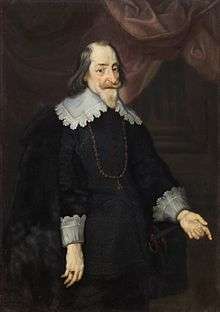 |
Maximilian I of Bavaria | 23 February 1623 | 24 October 1648 | Frederick V's territories and his position as Elector were transferred to the Duke of Bavaria, Maximilian I, of a distantly related branch of the House of Wittelsbach. Although technically Elector Palatine, he was known as the Elector of Bavaria. From 1648 he ruled in Bavaria and the Upper Palatinate alone, but retained all his Electoral dignities and the seniority of the Palatinate Electorate; see further Electorate of Bavaria. |
Second Electorate, 1648–1777
| Restored Simmern Line | ||||
| Image | Name | Began | Ended | Notes |
|---|---|---|---|---|
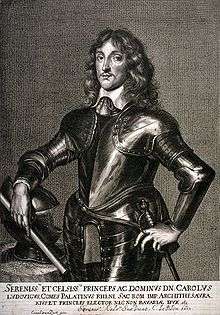 |
Charles I Louis Karl I Ludwig |
24 October 1648 | 28 August 1680 | Son of Frederick V. By the Peace of Westphalia in 1648, Charles Louis was restored to the Lower Palatinate, and given a new electoral title, also called "Elector Palatine", but lower in precedence than the other electorates. |
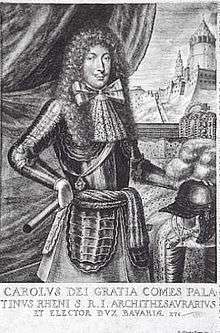 |
Charles II Karl II |
28 August 1680 | 26 May 1685 | Son of Charles I Louis. Last of the Simmern line. |
| Neuburg Line | ||||
| Image | Name | Began | Ended | Notes |
 |
Philip William Philipp Wilhelm |
26 May 1685 | 2 September 1690 | In 1685, the Simmern line died out, and the Palatinate was inherited by Philip William, Count Palatine of Neuburg (also Duke of Jülich and Berg), a Catholic and maternal nephew of Maximilian I of Bavaria |
 |
John William Johann Wilhelm |
2 September 1690 | 8 June 1716 | Son of Philip William |
 |
Charles III Philip Karl III Philipp |
8 June 1716 | 31 December 1742 | Brother of John William. Last of the Neuburg line. Moved the capital of the Palatinate from Heidelberg to Mannheim in 1720. |
| Sulzbach Line | ||||
| Image | Name | Began | Ended | Notes |
.jpg) |
Charles IV Theodore Karl IV Theodor |
31 December 1742 | 16 February 1799 | The Palatinate was inherited by Duke Charles Theodore of Sulzbach. Charles Theodore also inherited the Electorate of Bavaria when its ruling line became extinct in 1777. |
Electors of Bavaria and Counts Palatine of the Rhine, 1777–1803
| Sulzbach Line | ||||
| Image | Name | Began | Ended | Notes |
|---|---|---|---|---|
.jpg) |
Charles IV Theodore Karl IV Theodor |
30 December 1777 | 16 February 1799 | The title and authority of Elector Palatine were subsumed into the Electorate of Bavaria, Charles Theodore and his heirs retaining only the single vote and precedence of the Bavarian elector. They continued to use the title "Count Palatine of the Rhine" (German: Pfalzgraf bei Rhein, Latin: Comes Palatinus Rheni). |
| Zweibrücken Line | ||||
| Image | Name | Began | Ended | Notes |
 |
Maximilian II Joseph | 16 February 1799 | 27 April 1803 | Charles Theodore's heir, Maximilian Joseph, Duke of Zweibrücken (on the French border), brought all the Wittelsbach territories under a single rule in 1799. The Palatinate was dissolved in the Wars of the French Revolution. First, its left bank territories were occupied, and then annexed, by France starting in 1795; then, in 1803, its right bank territories were taken by the Margrave of Baden. The Rhenish Palatinate, as a distinct territory, disappeared. In 1806, the Holy Roman Empire was abolished, and all the rights and responsibilities of the electors with it. |
Later history
Only after the great restorations of 1815, the (Rhenish or Lower) Palatinate, albeit without any prince-elector role any longer, was restored as one of then eight Bavarian Districts (= provinces). After WW II the American Military Government for Germany took it away from Bavaria and put it together with neighbouring territories to form a new state called Rhenania-Palatinate (German: Rheinland-Pfalz) with Mainz as the state capital. The people – as far as the Palatinian share amongst them was concerned, having felt a deep sense of neglect from the side of the distant governments in Munich for generations – later approved by plebiscite. The present head of the House of Wittelsbach, Franz, Duke of Bavaria (born 1933) however is still traditionally styled as His Royal Highness the Duke of Bavaria, Duke in Swabia and Franconia, Count Palatine of the Rhine.
Notes
- ↑ Kohnle, Armin (2005). "Mittelalterliche Grundlagen; Pfalzgraftenamt, Territorialentwicklung und Kurwürde". Kleine Geschichte der Kurpfalz. Regionalgeschichte-fundiert und kompakt (in German) (First ed.). Karlsruhe: G. Braun Buchverlag. p. 17. ISBN 3-7650-8329-1.